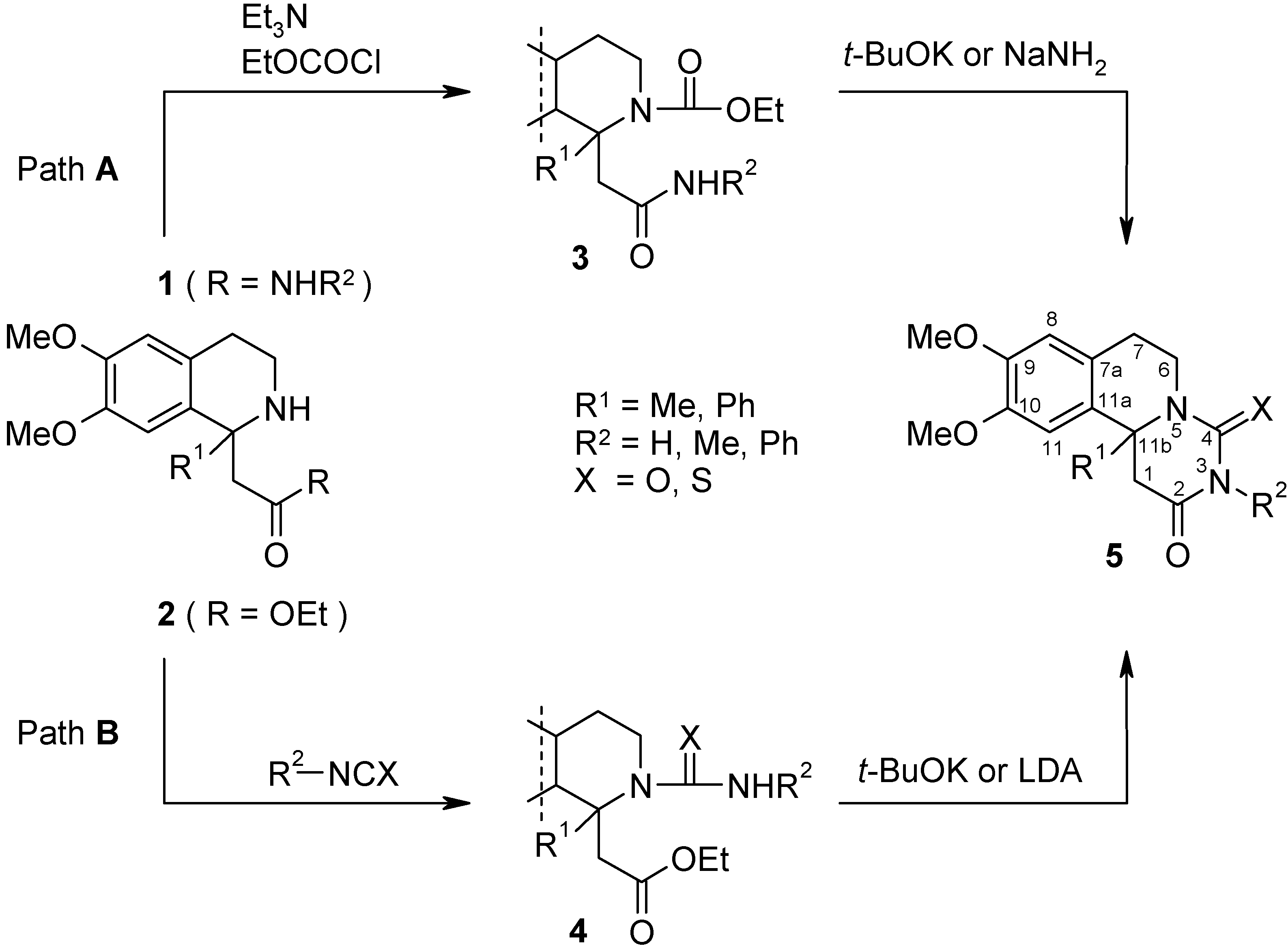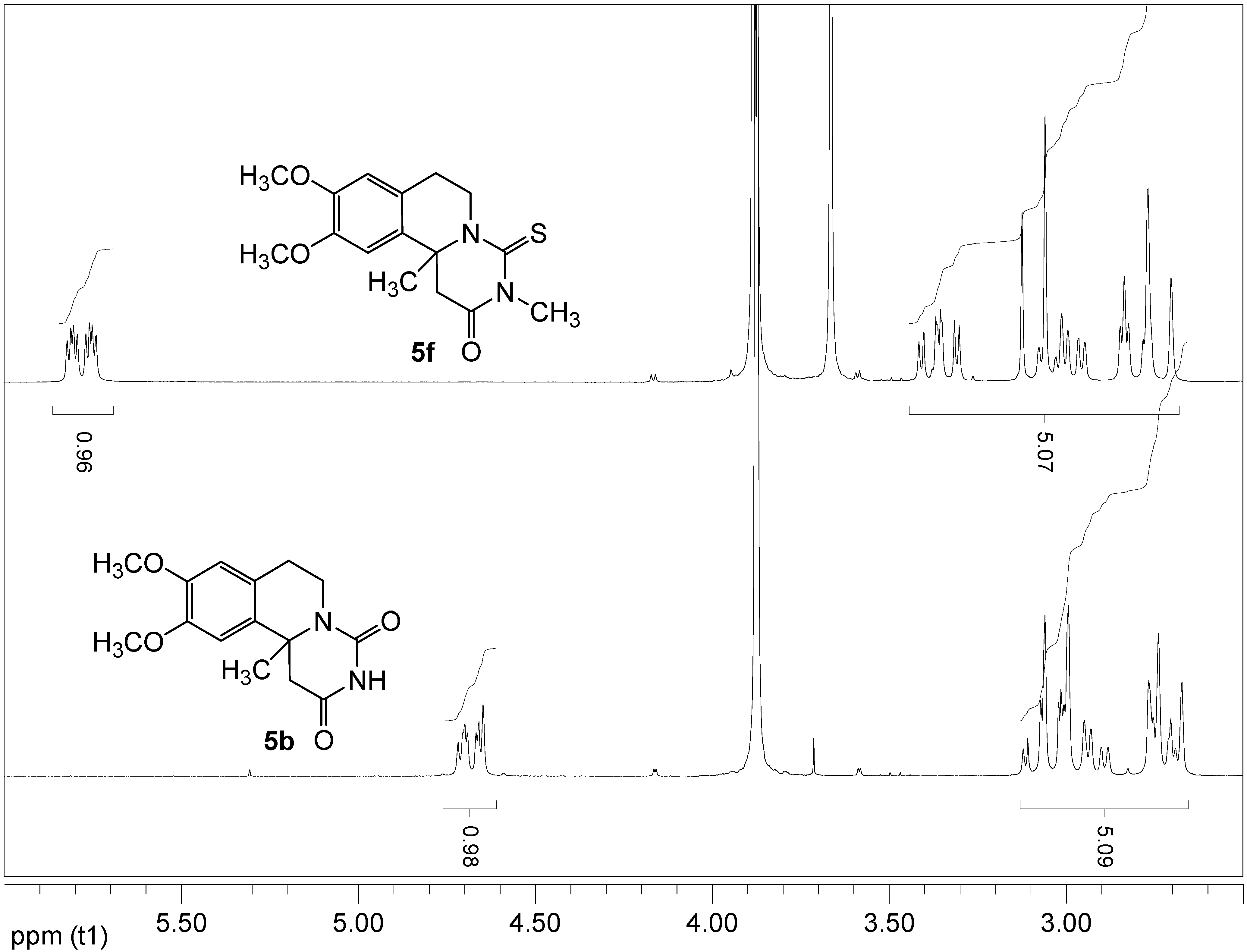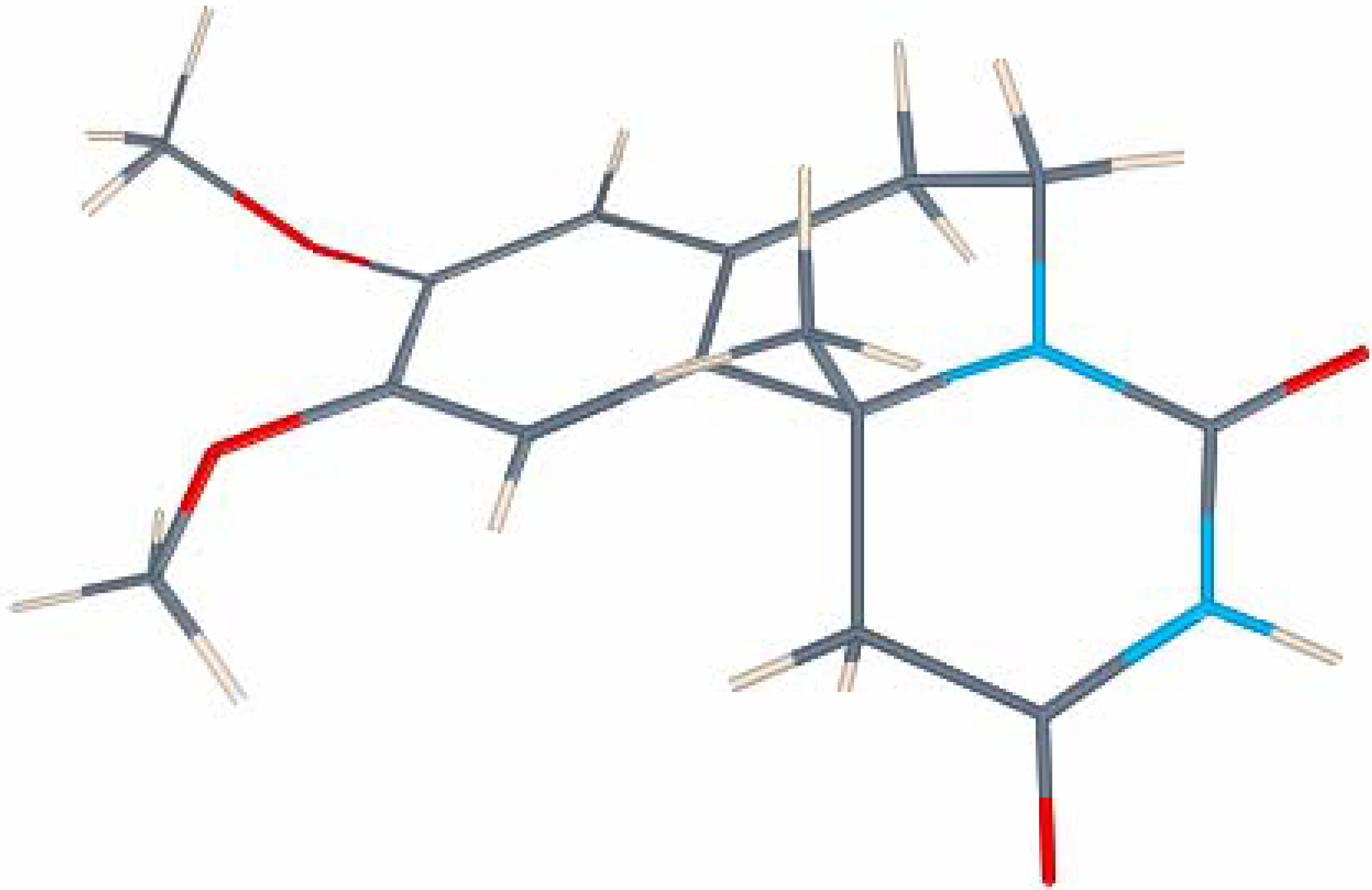Experimental
General
Melting points were determined on a Boëtius hotstage apparatus and are uncorrected. NMR spectra were recorded on a Bruker DRX-250 device using CDCl3 as solvent. Chemical shifts (δ, ppm) are downfield from TMS as internal standard and coupling constants are in Hz. IR spectra were recorded on a Perkin-Elmer 1750 FTIR device in KBr pellets and absorption is given in cm-1. All new compounds had elemental analyses within 0.4% of the theoretical values as well as correct molecular ion peaks by mass spectrometry.
Synthesis of tetrahydroisoquinolines 1 and 2
Compounds
1b,
d and
2d-g are described in reference [
16]. Compounds
1a,
c,
e are novel and were synthesized as follows: the corresponding β-ketoamide [
20] (2 mmol) and Na
2SO
4 (0.6 g) were added to a solution of homoveratrylamine (2 mmol) in CH
2Cl
2 (10 mL). The mixtures were stirred at r.t. for 14 days (entries
a,
e) or 2 days (entry
c). Then, the sulfate was filtered off and the solvent distilled. To the enaminones obtained in this way methanesulfonic acid (7 – 8 mL) was added and the mixtures were stirred at r.t. for 4 days (entries
a,
e) or 2 days (entry
c). After that, water (200 mL) was added, the pH brought to 9-10 with 25% aq. NH
3 and the tetrahydroisoquinolines
1 were extracted with CH
2Cl
2 (3 × 50 mL) After distillation of the solvent the products crystallize upon trituration with ether (or petroleum ether for
1c). The mother liquors could be further purified by column chromatography on neutral alumina, using ether as eluent.
2-(6,7-Dimethoxy-1-phenyl-1,2,3,4-tetrahydroisoquinolin-1-yl)-N-methyl-acetamide (1a): Yield 83 %; mp 107 – 108 oC; IR: νNH 3481, 3269; νC=O 1651; 1H-NMR: 2.56 (d, 3J = 4.8, 3H, CONHCH3), 2.68 – 3.10 (m, 5H, CH2CH2NH), 3.15 – 3.34 (AB quartet, 2J = 15.9, 2H, CH2CO), 3.74 (s, 3H, CH3O), 3.87 (s, 3H, CH3O), 6.50 (s, 1H, Ar-H), 6.60 (s, 1H, Ar-H), 7.14 – 7.32 (m, 5H, C6H5), 8.63 (br, 1H, CONHCH3); 13C-NMR: 25.17, 30.10, 39.87, 48.73, 55.54, 55.77, 60.23, 110.15, 111.22, 120.89, 125.53, 128.34, 129.91, 135.65, 138.30, 146.36, 147.73, 171.35.
2-(6,7-Dimethoxy-1-methyl-1,2,3,4-tetrahydroisoquinolin-1-yl)-N-methyl-acetamide (1c): Yield 90 %; mp 68 – 70 oC; IR: νNH 3416, 3268; νC=O 1657; 1H-NMR: 1.47 (s, 3H, CH3), 1.78 (br s, 1H, NH), 2.45 (d, 2J = 15.6, 1H, 0.5 × CH2CO), 2.69 – 3.20 (m, 4H, CH2CH2NH), 2.72 (d, 3J = 4.8, 3H, CONHCH3), 2.79 (d, 2J = 15.6, 1H, 0.5 × CH2CO), 3.85 (s, 6H, 2 × CH3O), 6.52 (s, 1H, Ar-H), 6.64 (s, 1H, Ar-H), 8.45 (br, 1H, CONHCH3); 13C-NMR: 25.11, 28.54, 30.24, 39.66, 46.47, 55.78, 55.79, 60.19, 109.05, 111.13, 129.07, 134.51, 146.06, 148.12, 172.67.
2-(6,7-Dimethoxy-1-phenyl-1,2,3,4-tetrahydroisoquinolin-1-yl)-N-phenyl-acetamide (1e): Yield 76 %; mp 202 – 204 oC; IR: νNH 3317, 3240; νC=O 1684; 1H-NMR: 2.69 – 3.05 (m, 5H, CH2CH2NH), 3.13 (d, 2J = 15.8, 1H, 0.5 × CH2CO), 3.36 (d, 2J = 15.8, 1H, 0.5 × CH2CO), 3.73 (s, 3H, CH3O), 3.82 (s, 3H, CH3O), 6.54 (s, 1H, Ar-H), 6.57 (s, 1H, Ar-H), 6.96 – 7.37 (m, 10H, 2 × C6H5), 11.12 (s, 1H, CONHC6H5); 13C-NMR: 29.12, 38.40, 47.94, 55.58, 55.90, 61.02, 110.11, 111.16, 119.78, 123.34, 126.47, 127.18, 127.31, 128.28, 128.59, 128.69, 138.30, 146.66, 147.39, 147.80, 168.84.
Synthesis of urethanes 3 – general procedure:
The solvents used in these preparations were 1,2-dichloroethane (3c,d), toluene (3a,e) and acetonitrile (3b). Ethyl chlorocarbonate (2 mmol) was added to a stirred solution of the corresponding tetrahydroisoquinoline 1 (1 mmol) and Et3N (1 mmol) in the specified solvent (15 mL) and the mixture was heated at reflux temperature for 1 h. The solvent was then evaporated in vacuo, the solid residue taken with CH2Cl2 (100 mL) and washed with 5% aq. hydrochloric acid (150 mL). The organic phase was dried, the solvent distilled off and the residue triturated with Et2O or petroleum ether to crystallize.
6,7-Dimethoxy-1-methylcarbamoylmethyl-1-phenyl-3,4-dihydro-1H-isoquinoline-2-carboxylic acid ethyl ester (3a): mp 127 – 128 oC; IR: νNH 3349; νC=O 1701, 1650; 1H-NMR: 1.21 (t, 3J = 7, 3H, CO2CH2CH3), 2.64 (d, 3J = 4.8, 3H, CONHCH3), 2.84 – 2.89 (m, 2H, CH2CH2N), 3.10 (d, 2J = 14.1, 1H, 0.5 × CH2CO), 3.47 (q, 3J = 7, 2H, CO2CH2CH3), 3.60 (s, 3H, CH3O), 3.85 (s, 3H, CH3O), 3.90 – 4.20 (m, 3H, CH2CH2N + 0.5 × CH2CO), 5.18 (br s, 1H, CONHCH3), 6.26 (s, 1H, Ar-H), 6.58 (s, 1H, Ar-H), 7.12 – 7.31 (m, 5H, C6H5).
1-Carbamoylmethyl-6,7-dimethoxy-1-methyl-3,4-dihydro-1H-isoquinoline-2-carboxylic acid ethyl ester (3b): mp 154 – 155 oC; IR: νNH 3416, 3347, 3227; νC=O 1685, 1658; 1H-NMR: 1.31 (t, 3J = 7, 3H, CO2CH2CH3), 1.75 (s, 3H, CH3), 2.65 – 2.91 (m, 2H, CH2CH2N), 2.75 (d, 2J = 13.7, 1H, 0.5 × CH2CO), 3.44 – 3.51 (m, 1H, 0.5 × CH2CH2N), 3.86 (s, 3H, CH3O), 3.88 (s, 3H, CH3O), 3.92 (d, 2J = 13.7, 1H, 0.5 × CH2CO), 3.94 – 4.04 (m, 1H, 0.5 × CH2CH2N), 4.18 (q, 3J = 7, 2H, CO2CH2CH3), 5.42 (br s, 1H, 0.5 × CONH2), 5.69 (br s, 1H, 0.5 × CONH2), 6.55 (s, 1H, Ar-H), 6.83 (s, 1H, Ar-H).
6,7-Dimethoxy-1-methyl-1-methylcarbamoylmethyl-3,4-dihydro-1H-isoquinoline-2-carboxylic acid ethyl ester (3c): mp 144 – 145 oC; IR: νNH 3360; νC=O 1692, 1640; 1H-NMR: 1.33 (t, 3J = 7, 3H, CO2CH2CH3), 1.71 (s, 3H, CH3), 2.61 – 2.90 (m, 2H, CH2CH2N), 2.68 (d, 3J = 4.8, 3H, CONHCH3), 2.70 (d, 2J = 13.5, 1H, 0.5 × CH2CO), 3.41 – 3.50 (m, 1H, 0.5 × CH2CH2N), 3.86 (s, 3H, CH3O), 3.87 (s, 3H, CH3O), 3.93 (d, 2J = 13.5, 1H, 0.5 × CH2CO), 3.93 – 4.05 (m, 1H, 0.5 × CH2CH2N), 4.16 (q, 3J = 7, 2H, CO2CH2CH3), 5.23 (br s, 1H, CONHCH3), 6.57 (s, 1H, Ar-H), 6.81 (s, 1H, Ar-H).
6,7-Dimethoxy-1-methyl-1-phenylcarbamoylmethyl-3,4-dihydro-1H-isoquinoline-2-carboxylic acid ethyl ester (3d): mp 169 – 170 oC; IR: νNH 3300; νC=O 1689, 1668; 1H-NMR: 1.35 (t, 3J = 7, 3H, CO2CH2CH3), 1.69 (s, 3H, CH3), 2.58 – 2.88 (m, 2H, CH2CH2N), 2.83 (d, 2J = 14.0, 1H, 0.5 × CH2CO), 3.38 – 3.49 (m, 1H, 0.5 × CH2CH2N), 3.87 (s, 3H, CH3O), 3.89 (s, 3H, CH3O), 3.90 – 4.04 (m, 1H, 0.5 × CH2CH2N), 4.01 (d, 2J = 14.0, 1H, 0.5 × CH2CO), 4.20 (q, 3J = 7, 2H, CO2CH2CH3), 6.56 (s, 1H, Ar-H), 6.79 (s, 1H, Ar-H), 7.02 – 7.61 (m, 6H, CONHC6H5).
6,7-Dimethoxy-1-phenyl-1-phenylcarbamoylmethyl-3,4-dihydro-1H-isoquinoline-2-carboxylic acid ethyl ester (3e): mp 172 – 173 oC; IR: νNH 3355; νC=O 1699, 1658; 1H-NMR: 1.25 (t, 3J = 7, 3H, CO2CH2CH3), 2.80 – 2.86 (m, 2H, CH2CH2N), 3.12 (d, 2J = 14.1, 1H, 0.5 × CH2CO), 3.53 (q, 3J = 7, 2H, CO2CH2CH3), 3.68 (s, 3H, CH3O), 3.84 (s, 3H, CH3O), 3.87 – 4.19 (m, 2H, CH2CH2N), 4.03 (d, 2J = 14.1, 1H, 0.5 × CH2CO), 6.30 (s, 1H, Ar-H), 6.57 (s, 1H, Ar-H), 6.72 (s, 1H, CONHC6H5), 6.95 – 7.33 (m, 10H, 2 × C6H5).
Synthesis of ureas 4 – general procedure:
Phenyl isocyanate (1.1 mmol) was added to a solution of 2 (1 mmol) in ether (10 - 20 mL) and the mixture was stirred overnight at r.t. The precipitated crystals were filtered off, washed with petroleum ether and dried.
(6,7-Dimethoxy-1-methyl-2-phenylcarbamoyl-1,2,3,4-tetrahydroisoquinolin-1-yl)-acetic acid ethyl ester (4d): mp 154 – 155 oC; IR: νNH 3375; νC=O 1709, 1656; 1H-NMR: 1.05 (t, 3J = 7.1, 3H, CO2CH2CH3), 1.84 (s, 3H, CH3), 2.84 – 2.89 (m, 2H, CH2CH2N), 2.97 (d, 2J = 16.0, 1H, 0.5 × CH2CO), 3.67 – 3.85 (m, 2H, CH2CH2N), 3.85 (s, 3H, CH3O), 3.87 (s, 3H, CH3O), 3.91 (q, 3J = 7.1, 2H, CO2CH2CH3), 4.23 (d, 2J = 16.0, 1H, 0.5 × CH2CO), 6.58 (s, 1H, Ar-H), 6.72 (s, 1H, CONHC6H5), 6.77 (s, 1H, Ar-H), 6.98 – 7.31 (m, 5H, C6H5).
(6,7-Dimethoxy-1-phenyl-2-phenylcarbamoyl-1,2,3,4-tetrahydroisoquinolin-1-yl)-acetic acid ethyl ester (4e): mp 159 – 160 oC; IR: νNH 3281; νC=O 1732, 1636; 1H-NMR: 1.14 (t, 3J = 7.1, 3H, CO2CH2CH3), 2.85 – 3.17 (m, 2H, CH2CH2N), 3.54 (d, 2J = 13.8, 1H, 0.5 × CH2CO), 3.55 – 3.66 (m, 1H, 0.5 × CH2CH2N), 3.65 (s, 3H, CH3O), 3.84 (s, 3H, CH3O), 3.96 (d, 2J = 13.8, 1H, 0.5 × CH2CO), 3.99 (q, 3J = 7.1, 2H, CO2CH2CH3), 4.39 – 4.51 (m, 1H, 0.5 × CH2CH2N), 6.33 (s, 1H, Ar-H), 6.40 (s, 1H, CONHC6H5), 6.59 (s, 1H, Ar-H), 6.92 – 7.54 (m, 10H, 2 × C6H5).
Tetrahydropyrimido[6,1-a]isoquinoline-2,4-diones 5a-e – General Procedure Path A:
A stirred suspension of the corresponding urethane 3 (1 mmol) and powdered sodium amide (1.2 equiv) in THF (10 – 15 mL) was heated at reflux temperature for 1h. The solvent was then evaporated, the solid residue was taken up with small amount of water and extracted with CH2Cl2 (75 – 100 mL). The organic phase was washed with water, dried and the solvent distilled off. All products crystallize upon trituration with Et2O.
Tetrahydropyrimido[6,1-a]isoquinoline-2,4-diones 5d, e – General Procedure Path B:
To a solution of the corresponding urea 4 (1 mmol) in THF (10 – 15 mL) was added LDA (1.2 equiv) and the mixture was stirred for 30 min. at r.t. After that, the solvent was evaporated in vacuo, and the solid residue was worked up as described above.
9,10-Dimethoxy-3-methyl-11b-phenyl-1,6,7,11b-tetrahydropyrimido[6,1-a]isoquinoline-2,4-dione (5a): mp 205 – 206 oC; IR: νC=O 1707, 1663; 1H-NMR: 2.70 – 3.02 (m, 2H, CH2CH2N), 3.08 (d, 2J = 16.4, 1H, 0.5 × CH2CO), 3.17 (s, 3H, NCH3), 3.59 (d, 2J = 16.4, 1H, 0.5 × CH2CO), 3.60 – 3.69 (m, 1H, 0.5 × CH2CH2N), 3.77 (s, 3H, CH3O), 3.88 (s, 3H, CH3O), 4.34 – 4.43 (m, 1H, 0.5 × CH2CH2N), 6.53 (s, 1H, Ar-H), 6.66 (s, 1H, Ar-H), 7.19 – 7.30 (m, 5H, C6H5); 13C-NMR: 27.67, 28.16, 40.21, 45.49, 55.82, 56.04, 59.62, 108.99, 111.12, 126.04, 126.51, 127.90, 128.69, 130.44, 142.84, 147.94, 148.34, 153.22, 168.15.
9,10-Dimethoxy-11b-methyl-1,6,7,11b-tetrahydropyrimido[6,1-a]isoquinoline-2,4-dione (5b): mp 257 – 258 oC; IR: νNH 3180; νC=O 1722, 1668; 1H-NMR: 1.63 (s, 3H, CH3), 2.70 (d, 2J = 16.4, 1H, 0.5 × CH2CO), 2.70 – 3.12 (m, 3H, CH2CH2N + 0.5 × CH2CH2N), 3.05 (d, 2J = 16.4, 1H, 0.5 × CH2CO), 3.87 (s, 3H, CH3O), 3.88 (s, 3H, CH3O), 4.65 – 4.70 (m, 1H, 0.5 × CH2CH2N), 6.58 (s, 1H, Ar-H), 6.62 (s, 1H, Ar-H), 8.84 (s, 1H, NH); 13C-NMR: 25.15, 28.80, 36.67, 45.76, 55.82, 55.87, 56.02, 107.75, 111.29, 125.29, 130.81, 148.08, 151.94, 168.58.
9,10-Dimethoxy-3,11b-dimethyl-1,6,7,11b-tetrahydropyrimido[6,1-a]isoquinoline-2,4-dione (5c): mp 185 – 186 oC; IR: νC=O 1707, 1657; 1H-NMR: 1.57 (s, 3H, CH3), 2.71 (d, 2J = 16.2, 1H, 0.5 × CH2CO), 2.71 – 3.13 (m, 3H, CH2CH2N + 0.5 × CH2CH2N), 3.07 (d, 2J = 16.2, 1H, 0.5 × CH2CO), 3.27 (s, 3H, NCH3), 3.87 (s, 3H, CH3O), 3.88 (s, 3H, CH3O), 4.65 – 4.72 (m, 1H, 0.5 × CH2CH2N), 6.58 (s, 1H, Ar-H), 6.63 (s, 1H, Ar-H); 13C-NMR: 24.88, 27.68, 28.85, 37.44, 46.13, 54.38, 55.77, 55.96, 107.60, 111.21, 125.33, 130.99, 148.00, 152.76, 168.24.
9,10-Dimethoxy-11b-methyl-3-phenyl-1,6,7,11b-tetrahydropyrimido[6,1-a]isoquinoline-2,4-dione (5d): mp 263 – 264 oC; IR: νC=O 1718, 1666; 1H-NMR: 1.75 (s, 3H, CH3), 2.73 – 3.19 (m, 3H, CH2CH2N + 0.5 × CH2CH2N), 2.92 (d, 2J = 16.2, 1H, 0.5 × CH2CO), 3.23 (d, 2J = 16.2, 1H, 0.5 × CH2CO), 3.87 (s, 3H, CH3O), 3.89 (s, 3H, CH3O), 4.65 – 4.72 (m, 1H, 0.5 × CH2CH2N), 6.62 (s, 1H, Ar-H), 6.65 (s, 1H, Ar-H), 7.19 – 7.48 (m, 5H, C6H5); 13C-NMR: 25.53, 27.82, 36.38, 45.89, 55.41, 55.68, 56.73, 107.98, 111.09, 125.94, 127.13, 128.52, 131.07, 140.34, 145.34, 148.11, 153.05, 168.12.
9,10-Dimethoxy-3,11b-diphenyl-1,6,7,11b-tetrahydropyrimido[6,1-a]isoquinoline-2,4-dione (5e): mp 277 – 278 oC; IR: νC=O 1713, 1673; 1H-NMR: 2.78 – 3.10 (m, 2H, CH2CH2N), 3.27 (d, 2J = 16.4, 1H, 0.5 × CH2CO), 3.69 – 3.78 (m, 1H, 0.5 × CH2CH2N), 3.75 (d, 2J = 16.4, 1H, 0.5 × CH2CO), 3.78 (s, 3H, CH3O), 3.89 (s, 3H, CH3O), 4.38 – 4.50 (m, 1H, 0.5 × CH2CH2N), 6.58 (s, 1H, Ar-H), 6.69 (s, 1H, Ar-H), 6.96 – 7.39 (m, 10H, 2 × C6H5); 13C-NMR: 27.70, 41.02, 45.78, 56.12, 57.05, 58.97, 110.06, 111.31, 120.54, 123.13, 125.07, 127.30, 127.76, 128.45, 128.62, 128.69, 138.39, 147.06, 147.41, 148.09, 154.03, 168.36.
4-Thioxo-1,3,4,6,7,11b-hexahydropyrimido[6,1-a]isoquinolin-2-ones 5f,g – General Procedure:
A mixture of the corresponding tetrahydroisoquinoline 2 (1 mmol) and methyl or phenyl isothiocyanate (2 mmol) was heated in an open reaction vessel at 120 oC for 10 min. The mixture was then allowed to cool to r.t. and the obtained crystalline product was washed with ether.
9,10-Dimethoxy-3,11b-dimethyl-4-thioxo-1,3,4,6,7,11b-hexahydropyrimido[6,1-a]isoquinolin-2-one (5f): mp 188 – 190 oC; IR: νC=O 1702; 1H-NMR: 1.61 (s, 3H, CH3), 2.73 (d, 2J = 16.5, 1H, 0.5 × CH2CO), 2.78 – 3.42 (m, 3H, CH2CH2N + 0.5 × CH2CH2N), 3.09 (d, 2J = 16.5, 1H, 0.5 × CH2CO), 3.67 (s, 3H, NCH3), 3.87 (s, 3H, CH3O), 3.89 (s, 3H, CH3O), 5.74 – 5.82 (m, 1H, 0.5 × CH2CH2N), 6.57 (s, 1H, Ar-H), 6.66 (s, 1H, Ar-H); 13C-NMR: 23.89, 28.75, 34.69, 45.90, 46.08, 55.87, 56.07, 58.20, 107.54, 111.06, 125.62, 130.68, 148.21, 165.71, 180.43.
9,10-Dimethoxy-11b-methyl-3-phenyl-4-thioxo-1,3,4,6,7,11b-hexahydropyrimido[6,1-a]isoquinolin-2-one (5g): mp 280 oC (dec.); IR: νC=O 1703; 1H-NMR: 1.81 (s, 3H, CH3), 2.79 – 3.50 (m, 3H, CH2CH2N + 0.5 × CH2CH2N), 2.97 (d, 2J = 16.3, 1H, 0.5 × CH2CO), 3.23 (d, 2J = 16.3, 1H, 0.5 × CH2CO), 3.87 (s, 3H, CH3O), 3.89 (s, 3H, CH3O), 5.73 – 5.81 (m, 1H, 0.5 × CH2CH2N), 6.61 (s, 1H, Ar-H), 6.68 (s, 1H, Ar-H), 7.19 – 7.51 (m, 5H, C6H5); 13C-NMR: 26.17, 27.62, 46.03, 46.29, 55.57, 55.73, 57.95, 108.07, 111.18, 126.13, 127.87, 128.02, 131.35, 140.97, 145.52, 148.01, 166.02, 180.32.







